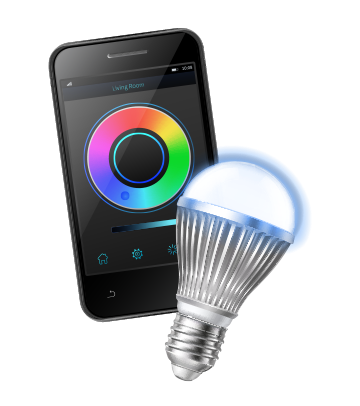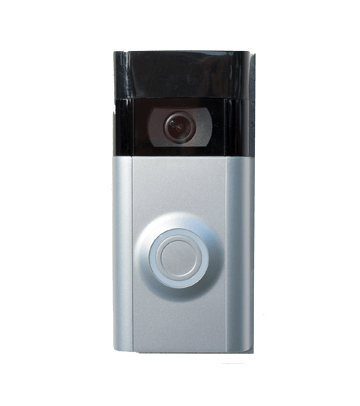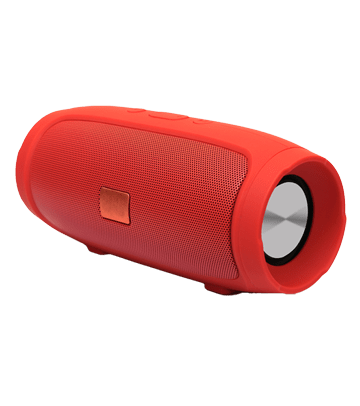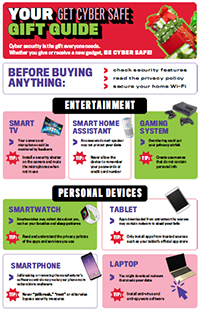
Cyber security is a gift that never goes out of style. Whether you’re giving a gadget, receiving one, or treating yourself these holidays — follow these tips to stay cyber safe.
Before you buy a smart device
Be a smart consumer when you buy a smart device. While you are doing your comparison shopping, take the product’s security features and privacy policy into account, too!
Security Features: Some smart device manufacturers design their products to be easy to use and low cost to the consumer. But this can mean that the device's security features are weak or non-existent. When buying a new smart device, think about what data will be transmitted through the device, then research how the device will be protecting that data. At a minimum, check to see if the device will give you the option to create your own strong and unique password.
Privacy Policy: Smart devices can capture and transmit so much private information about us: our daily routines, our fitness and health habits, and our personal banking and payment information. So, before you buy a smart device, check to see how the vendor will be protecting the privacy of your information. Reputable smart device vendors will have a published policy that will explain the types of data their device will collect about you, how they will protect the privacy of your data and which companies and advertisers they will share your data with. In short, be sure to look for, and understand, the vendor's privacy policy and terms of use.
One more thing! Almost all smart devices will rely on your home Wi-Fi network for their connection. To secure your home Wi-Fi:
- Make sure your Wi-Fi router has WPA2 encryption enabled.
- Secure your Wi-Fi with a strong and unique password. A strong password includes uppercase and lowercase letters, numbers, and special characters. Even better, use a passphrase made of four or more random words and at least 15 characters.
- Create a separate guest network on your Wi-Fi network to connect your smart devices. This will prevent a cyber criminal from getting access to your other devices if your smart devices are compromised.
Categories
Smart Speakers

Smart speakers, also known as "voice-activated assistants", are speakers that include a microphone connected to a voice recognition system. Smart speakers can stream music and podcasts, perform automated tasks, make online purchases or operate household devices.
Risks:
- A smart speaker's microphone could capture and transmit information you don't intend it to.
- A smart speaker's online purchasing function could expose your payment info.
Tips:
- Secure your smart speaker with a strong and unique password and enable multi-factor authentication (MFA) if it is available on the device.
- Enable its software to install updates automatically.
- Don't use your smart speaker to remember sensitive information such as passwords or credit card numbers.
- Turn off the online purchasing function if you're not using it, or secure it with a strong and unique purchase password.
- Be selective about which devices and accounts you link to your smart speaker.
- If you're not using the voice commands, you can mute the device's microphone.
- If you are using the voice commands, there are some things you can do:
- Don't place your smart speakers where strangers can make use of the voice commands, like by an open window.
- Get into the habit of logging in to your account to verify the types of voice data that it is recording and adjust your privacy and data retention settings as needed.
- Your smart speaker may have a feature where it will "fingerprint" or learn to recognize your voice and associate it to your account. Enabling this feature will help prevent unauthorized users from using voice commands to access your information (such as email or calendar appointments) or to make purchases on your account.
Smart TVs, projectors and streaming sticks

Smart TVs, projectors and streaming sticks connect to your home's Wi-Fi network so that you can access streaming services, run apps and browse the internet.
Risks:
- A smart TV's camera and microphone could capture and transmit information you don't intend them to.
- The manufacturer's app store on these devices may be less trustworthy than the Google Play Store or Apple App Store.
Tips:
- If your smart TV has a camera, install a camera cover or deactivate the camera when not in use.
- If your smart TV has a microphone, deactivate it or mute it when not in use.
- Enable the device’s software and apps to install updates automatically.
- When installing apps on your smart TV or streaming stick, note that manufacturer app stores may be less trustworthy than the Google Play store or Apple store.
- Before installing new apps on your smart TV, take a look at the app's privacy policy and terms of use.
- Get into the habit of logging in to your account to verify the types of data that it is recording and adjust your privacy and data retention settings as needed.
Gaming

From the casual to the competitive gamer, there are gaming systems to match all levels and interests. Some gaming systems also feature virtual reality (VR) components.
Risks:
- An unsecured gaming system could expose your personal info.
- Oversharing could put your privacy at risk.
- Immersive games could make you unaware of your surroundings.
Tips:
- Create usernames that don't contain identifying info, like your real name, location or birthdate.
- Secure your gaming account with a strong and unique password or passphrase. A strong password includes uppercase and lowercase letters, numbers, and special characters. A strong passphrase has four or more random words that have at least 15 characters.
- In settings, turn off geolocation when not in use.
- If your gaming system has a camera, disable it when not in use.
- If you are using a gaming headset with a microphone, disable it when not in use.
- Be mindful of who and what is around you when you play.
Smartphones, tablets and laptops

Personal devices such as tablets, laptops and smartphones can be infected by cyber criminals who use malicious software (malware) to access your information, your money and even your identity.
Risks:
- An unsecured device could expose your location.
- Apps on your devices may collect and relay your data even when not in use.
- Small devices could easily get lost or stolen.
- Malware could be used to steal your data.

Tips:
- Secure your device with a strong and unique password or passphrase. A strong password includes uppercase and lowercase letters, numbers, and special characters, and a strong passphrase is made up of four or more random words and at least 15 characters.
- Enable biometrics or smart-lock features (such as fingerprint, face or voice recognition).
- Enable the auto-lock feature so that your device always locks automatically when not in use.
- Keep your device's operating system up to date; you can enable it to install updates automatically.
- Only download apps from trusted sources such as the Apple App Store or the Google Play store. Remember that apps downloaded from official app stores could still be malicious, and you should always be cautious when downloading any apps.
- Don’t give apps access to more of your device’s resources or private information (camera, microphone, contacts, etc.) than they need or you are comfortable with sharing.
- Install anti-virus protection on your devices.
- Check to see if your tablet or smartphone manufacturer has a "device health" app and make use of it.
- Don't "jailbreak", "root" or otherwise disable security measures imposed by your device's manufacturer.
Around the home

Many household appliances and devices—including refrigerators, electronic door locks, doorbells, decorative lights, sleep machines and vacuums—now come in internet-enabled versions.
Risks:
- A smart device could be hacked and give access to your Wi-Fi network.
- Your daily routine could be exposed.
- Devices could capture and transmit data you don’t intend them to.

Tips:
- Read the device’s privacy policy and terms of use.
- Some smart devices come with a default username provided by the manufacturer. You should change this — if you can.
- Secure each smart device with a strong and unique password or passphrase. A strong password is at least 12 characters and includes uppercase and lowercase letters, numbers, and special characters. A strong passphrase is made of 4 or more random words and contains at least 15 characters.
- Keep your smart device's software up to date; you can enable some to install updates automatically.
- Create a separate guest network on your Wi-Fi network to connect your smart devices. This prevents a cyber criminal from getting access to your other devices if your smart device is compromised.
On the go
Items that charge our devices or help us on the go – phone cases that are also chargers, stroller hook chargers, smart travel mugs, wireless earphones and portable speakers — also have unique cyber security risks. Using these devices in transit might mean connecting them to outside Wi-Fi networks, which exposes your device to more cyber criminals and cyber threats.
Risks:
- Any device that isn’t your own plugged into a smart charger could leave your network exposed.
- Devices connected to networks or other smart devices, like your phone, could be hacked and expose your data.

Tips:
- Portable charging solutions are great for on the go. Keep them charged up and only use them with your own secure devices.
- Disable any features you don’t need, such as Bluetooth or location services. Turn off devices when not in use.
Smartwatches

A smartwatch takes the many useful features from a smartphone and compacts them into a watch on your wrist. A smartwatch can help balance a busy schedule, track health data or connect with others without using a phone.
Risks:
- Smartwatches collect and send personal information (such as your location or activities) to other devices, cloud accounts and storage, and third-party applications using Bluetooth and the Internet.
- Smartwatches can access and control your other smart devices, which can spread a cyber threat if it is compromised.
- Apps collect and relay personal data whenever your smartwatch is online and being worn.
- Compromised smartwatches can spread malware to other connected devices to steal information or restrict the smartwatch’s service entirely.
Tips on how to secure it:
- Ensure your device is secured by locking it with a PIN or biometric. If you lose your smartwatch, some models will allow you to remotely lock it.
- Keep your smartwatch software updated and enable automatic updates if possible.
- When using a fitness app or any third-party app, check your smartwatch privacy settings. You can usually select what information will be shared with certain apps.
- Be selective about what you link to your smartwatch, such as financial information and location services.
- Turn off the microphone and camera on your smartwatch when not in use.
- Read your device’s terms of use to learn how your data is being collected.
Wireless earbuds or headphones
Wireless earbuds or headphones, like other smart devices, connect to other devices using Bluetooth. They are vulnerable to cyber attacks if not secured properly. They include many risks due to the large amount of data circulating between paired devices.
Risks:
- Anyone can eavesdrop on conversations you have using your headphones by compromising wireless signals.
- A compromised wireless signal can allow others to connect to your devices and steal unsecured sensitive data.
- Wireless earphones can be hacked to execute volume changes or skipping tracks while in use.
- Compromised headphones can be disconnected from your device and redirected to connect to a spoofed device.
Tips on how to secure it:
- Purchase a pair of headphones that has additional security features that require a PIN to connect or allows you to choose which device to connect to.
- Use headphones with the most recent version of Bluetooth function.
- Update the software and firmware for your earphones regularly. Enable automatic updates if available.
- Do not discuss sensitive information over wireless earphones in a public space.
- Disable connections and turn off devices when not in use.
Health and fitness

Wearables and smart fitness equipment that track your health data and progress have a lot of your personal information. This can make them valuable targets for cyber criminals.
Risks:
- Wearables like a fitness tracker could capture and transmit information you don't intend them to.
- Health and fitness equipment that connect to your social media accounts could expose your location and daily routines.
- A smart device could be hacked and give access to your Wi-Fi network.
- Connecting to unsecured Wi-fi networks can expose your information to cyber criminals.
Tips:
- If your device has a microphone or a camera, disable them when not in use.
- Keep your fitness equipment’s operating system up to date. You can enable some to install updates automatically.
- Before installing new apps on your fitness equipment, take a look at the app's privacy policy and terms of use. Be wary of apps asking for unnecessary or excessive information.
- Be careful about allowing the apps on your fitness equipment to share your location on social media.
Protect all your gadgets these holidays so you can enjoy them to their fullest. Cyber safe greetings from our devices to yours!
